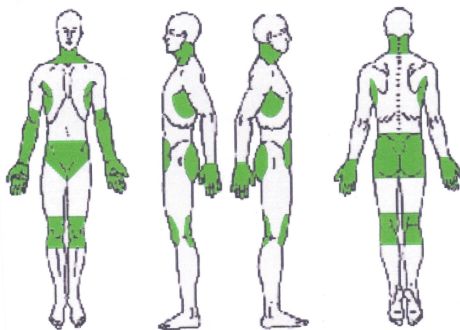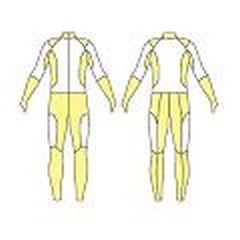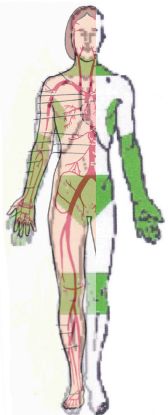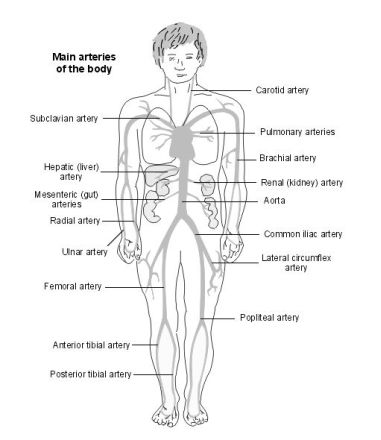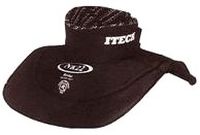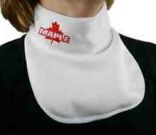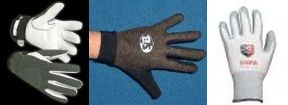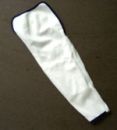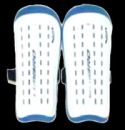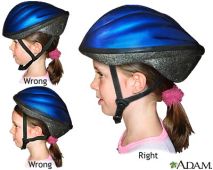SAFETY! IS YOUR CHILD TRULY PROTECTED??
|
Every society, all government, and every kind of civil compact therefore, is or ought to be, calculated for the general good and safety of the community. ~ George Mason |
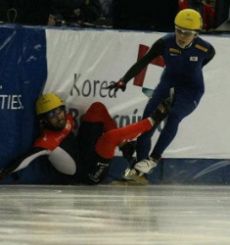 WARNING! Yes, this is a REAL photo!
(The skater in blue was not injured)
Due to the graphic content of this article it may not be suitable for some young readers. Parental guidance is advised!
WARNING! Yes, this is a REAL photo!
(The skater in blue was not injured)
Due to the graphic content of this article it may not be suitable for some young readers. Parental guidance is advised!
Wow! I just realized this is the first time I’ve ever put an entire title of an article in capital letters and super sized it. I guess that’s how strongly I feel about this article.
Yes, the sport of speed skating has come a long way from my early days when we used hay bales for board protection, skated bare handed, with a flimsy leather helmet, and no neck, knee, shin, or cut resistant protection. But I have to say, we are nowhere near having the safety standards we need now in this sport.
I am writing this article for a couple of reasons:
This year alone I have witnessed two very serious accidents in which skaters were severely cut. One almost affected an Olympian's career, but he was lucky in the sense that he will skate again. The other was not so lucky, and although the athlete sustained Class IV hemorrhage she did survive. This athlete** sustained a severed femoral artery and femoral vein, severed sciatic nerve, and complete severance of the ham stings, quadratus femoris, gracilis, and sartorius muscle groups. With injuries of this severity there is high potential of long term significant disability. The irony of both incidents is that both athletes were wearing ISU Standard cut resistant suits. A couple of years ago I witnessed a cut on a young athlete extending from the top of the shoulder to below the shoulder blade. It took 65 stitches to close in a lengthy surgery.
How could this have happened??? Aren’t you protected if the International governing body says you are? As a lay parent in the sport if they tell you it is safe, you are likely to take it for granted, right? Have a look at the diagram below of the ISU Standard for areas of protection. Now look at the diagram of the major arteries of the body. The Olympian was cut above the knee in front where there was no protection. The other young athlete was cut on the back of the thigh.
Yes, the sport of speed skating has come a long way from my early days when we used hay bales for board protection, skated bare handed, with a flimsy leather helmet, and no neck, knee, shin, or cut resistant protection. But I have to say, we are nowhere near having the safety standards we need now in this sport.
I am writing this article for a couple of reasons:
- To make parents and skaters aware of the differences in the adequacy, or lack thereof, of safety equipment and safety regulations
- To have associations, including club, state, provincial, national, and the ISU come up with standards that will truly prevent major injury and save lives
This year alone I have witnessed two very serious accidents in which skaters were severely cut. One almost affected an Olympian's career, but he was lucky in the sense that he will skate again. The other was not so lucky, and although the athlete sustained Class IV hemorrhage she did survive. This athlete** sustained a severed femoral artery and femoral vein, severed sciatic nerve, and complete severance of the ham stings, quadratus femoris, gracilis, and sartorius muscle groups. With injuries of this severity there is high potential of long term significant disability. The irony of both incidents is that both athletes were wearing ISU Standard cut resistant suits. A couple of years ago I witnessed a cut on a young athlete extending from the top of the shoulder to below the shoulder blade. It took 65 stitches to close in a lengthy surgery.
How could this have happened??? Aren’t you protected if the International governing body says you are? As a lay parent in the sport if they tell you it is safe, you are likely to take it for granted, right? Have a look at the diagram below of the ISU Standard for areas of protection. Now look at the diagram of the major arteries of the body. The Olympian was cut above the knee in front where there was no protection. The other young athlete was cut on the back of the thigh.
|
It seems pretty obvious to me that there are several areas that are lacking coverage, despite the fact that major arteries run through these unprotected places. Yet, many skin suits are made with built-in coverage to conform to the minimum ISU Standard as shown above.
There are undersuits available that do offer better protection than the minimum ISU Standard. However, even these suits can leave vital arterial areas unprotected as well as major organs such as the kidneys and liver. Below are some of the undersuits on the market today. All white areas are non-cut resistant areas. Compare these with the diagram of major arteries and organs. |
|
Some of the wording in promoting some undersuits could be perceived as misleading to the uninformed buyer. A phrase such as “the areas of risk have all been covered” might lead people to believe there is more comprehensive coverage by the suit than what really exists. I think what the advertising is saying is ‘all areas of risk according to the ISU Standard are covered’ but this needs more clarification as it is clear to me when comparing the suit to the diagrams of the arteries that some major arteries not covered. One advertisement quotes “integrated full-body skin suit protection, cut-proof lined undergarment provides a layer of cut-resistant materials”. Reading this might lead people to think the cut resistant material covers the full body, where in fact, it does not. What I think they are trying to say is the suit is a ‘one piece full body undergarment that has built-in protection in certain areas’. The good news is most undersuits do have more protected area than the paltry ISU Standard, but the bad news is that it may not be enough. If a blade were to strike a skater from the side, on an unprotected part, it would simply be able to continue to travel through the body, pushing the cut resistant material aside, like a curtain being drawn back, cutting through tissue and arteries.
|
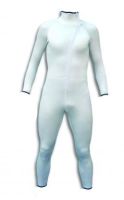
I have only found one full coverage body suit on the market today (although there may be others I haven’t found) and that is the Sebra Suit II Extreme. It comes in either a one piece or you can get the top and bottoms separately. The only thing that needs to be added to this suit is a pair of high-cut cut resistant gloves and ankle protection. Skaters have shied away from full coverage suits of the past as the suits tended to be restrictive, hot, and itchy. The Sebra Extreme II suit is made from Dyneema and a couple of local skaters who have purchased it say it is very comfortable and does not itch or restrict movement. The Sebra Suit II Extreme does cost considerably more than traditional suits though, but what is a life worth? The main reason they are so expensive right now is that there are so few sold. If a suit of this type became the standard more would be sold and perhaps then the price would be more reasonable. (There is also a Sebra 1265 sold and although this suit meets ISU standards, it is only partial coverage. Only the Extreme II has full coverage.)
OK, so maybe you have already splurged on what you thought was a really safe skin suit or undersuit. What you can do is purchase some cut resistant material and sew in patches of the material over the areas that are lacking in your suit. Make sure the material you are sewing in is of a high cut resistance though!
One thing that came to light in researching this article is that there are different grades of cut resistant material. Not all cut resistant products are made the same so just because a product says it is cut resistant does not necessarily mean it will do the job you want it to do. The original ISU Standard* for cut resistant clothing (Communication 1159) said it must meet a Cut Index rating of 5.94 according to EN388, which sets standards for different safety materials. Finding facts on these ratings and standards and how to interpret them proved challenging and somewhat foggy but perhaps the following chart can best explain it.
EN388 CUT PERFORMANCE LEVELS
Performance Average Cut Index
Level (10 measurements)
0 < 1.2
1 1.2-2.4
2 2.5-4.9
3* 5.0-9.9*
4 10.0-19.9
5 > 20
So, the original ISU rule said protective material must meet a Cut Index Level of 5.94, which means it has a Performance Level of at least 3 according to the above chart, if I am interpreting it correctly.
Many of the cut resistant suits available now rated a grade 2. While the suit may meet ISU Standards in terms of coverage area, it would not meet it in terms of cut resistance under the original ISU standard. My original article stated level 2 cut resistance does not meet ISU Standards. I stand corrected as I was unaware that the ISU actually LOWERED their standard from level 3 to level 2 in 2004 (Communication 1265). The ISU rationale for lowering the standard was lack of availability of material, but the material was available and is even more readily available in today’s market!! Read the article Safety! Is Your Child Truly Protected? – Part 2 – February 2010 for more on this. Simple experiments by some interested parents wanting to see for themselves how cut resistant some of the ‘cut resistant’ material really was found that most were, in fact, fairly easily cut. Not even really cut resistant, let alone ‘cut proof’ as some advertise. The exception to this was the material made from Dyneema, which I am told is rated at a 4 on the EN388 Cut Index chart. While nothing we use in skating right now is totally cut proof, it would seem the higher the level of cut resistance the more protection we have.
There are also some claims that Kevlar can’t be washed as it breaks down the cut resistant material, however, the manufacturer says it can be washed many times without affecting cut resistance, but cautions against the use of bleach and suggests monitoring for wear. According to the Sept/Oct 08 issue of Glass Worldwide Kevlar can start to lose its strength retention when laundered with detergents with a ph base of 8 (most are 8 or more).
There are a few add-ons you can buy separately to give additional protection to areas not adequately covered by your built-ins or undersuits. But again the quality/coverage is not the same for all of these products. When searching for neck guards, for example, find one that is high cut, covering the whole neck. In many cases, when checking to make sure skaters have their neck guards on, I can’t even see it because it sits so low on their neck. How is it going to protect the carotid artery if it’s not even covering it? You should try on different neck guards, first to find the right size for you, and secondly to make sure it is high enough to give the best coverage possible. Even some of the built-in neck protectors are too low cut to really adequately protect.
The Speed Skate Canada rule on neck protection reads:
One thing that came to light in researching this article is that there are different grades of cut resistant material. Not all cut resistant products are made the same so just because a product says it is cut resistant does not necessarily mean it will do the job you want it to do. The original ISU Standard* for cut resistant clothing (Communication 1159) said it must meet a Cut Index rating of 5.94 according to EN388, which sets standards for different safety materials. Finding facts on these ratings and standards and how to interpret them proved challenging and somewhat foggy but perhaps the following chart can best explain it.
EN388 CUT PERFORMANCE LEVELS
Performance Average Cut Index
Level (10 measurements)
0 < 1.2
1 1.2-2.4
2 2.5-4.9
3* 5.0-9.9*
4 10.0-19.9
5 > 20
So, the original ISU rule said protective material must meet a Cut Index Level of 5.94, which means it has a Performance Level of at least 3 according to the above chart, if I am interpreting it correctly.
Many of the cut resistant suits available now rated a grade 2. While the suit may meet ISU Standards in terms of coverage area, it would not meet it in terms of cut resistance under the original ISU standard. My original article stated level 2 cut resistance does not meet ISU Standards. I stand corrected as I was unaware that the ISU actually LOWERED their standard from level 3 to level 2 in 2004 (Communication 1265). The ISU rationale for lowering the standard was lack of availability of material, but the material was available and is even more readily available in today’s market!! Read the article Safety! Is Your Child Truly Protected? – Part 2 – February 2010 for more on this. Simple experiments by some interested parents wanting to see for themselves how cut resistant some of the ‘cut resistant’ material really was found that most were, in fact, fairly easily cut. Not even really cut resistant, let alone ‘cut proof’ as some advertise. The exception to this was the material made from Dyneema, which I am told is rated at a 4 on the EN388 Cut Index chart. While nothing we use in skating right now is totally cut proof, it would seem the higher the level of cut resistance the more protection we have.
There are also some claims that Kevlar can’t be washed as it breaks down the cut resistant material, however, the manufacturer says it can be washed many times without affecting cut resistance, but cautions against the use of bleach and suggests monitoring for wear. According to the Sept/Oct 08 issue of Glass Worldwide Kevlar can start to lose its strength retention when laundered with detergents with a ph base of 8 (most are 8 or more).
There are a few add-ons you can buy separately to give additional protection to areas not adequately covered by your built-ins or undersuits. But again the quality/coverage is not the same for all of these products. When searching for neck guards, for example, find one that is high cut, covering the whole neck. In many cases, when checking to make sure skaters have their neck guards on, I can’t even see it because it sits so low on their neck. How is it going to protect the carotid artery if it’s not even covering it? You should try on different neck guards, first to find the right size for you, and secondly to make sure it is high enough to give the best coverage possible. Even some of the built-in neck protectors are too low cut to really adequately protect.
The Speed Skate Canada rule on neck protection reads:
|
"All skaters must wear a neck protector during short track competitions. The neck protector must be of a bib type design covering the neck and all the soft parts of the upper chest area. It must be made with ballistic nylon as the main material. The neck protector must be securely fastened and tucked into the skin suit."
|
So does this mean that Kevlar and Dyneema are not acceptable materials in Canada? I don’t think that’s the case but the rule, as written, is not specific about it (at least not that I can find). And what soft parts of the upper chest area are they referring to. How far along the top of the shoulders should the bib extend, and should it be required to extend down the back as well to be safe? From what I can see of the ISU required coverage area, there is not even a bib area marked out on the diagram.
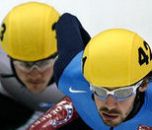
Many associations in Canada have made eye protection mandatory as well. The eye protection must be a sturdy sport frame with shatter proof lenses (ANSI Z87.1) and CLEAR or YELLOW lenses, and must be attached with a strap which holds the frame securely to the head. Some of the eye wear kids are wearing now might look cool, but does not really protect as they don’t fit close enough to the face and can easily be knocked around by a blade or errant arm swing. Also, dark coloured lenses not only can obscure the skaters vision, but if a skater is down on the ice and not moving the response team has an immediate problem in assessing them if they can’t see their eyes. So, parents, do you really want to choose cool because your kid is begging to look cool or do you want to protect? Actually I think these guys look pretty cool in their goggles that also safely protect.
|
We do seem to have come a long way in terms of improving standards for helmets. However, the way the helmet is worn is just as important as what it’s made of. The helmet should sit squarely on the head so the front brim extends down over the forehead and is not sitting at the back of your child’s head with the forehead exposed! Also make sure the straps are properly tightened and snug under the chin.
|
Rink Safety
So now that we’ve got the body covered, and hey, I’m on a safety roll, let’s look at just how safe you or your kids are on the ice once you have outfitted them with the right body gear.
In researching something else on the internet I came across a video of a club practice where there was no safety board padding (mats) whatsoever. Not that these guys were tearing up the ice with their speed mind you, but even a simple fall can result in serious injury. An Olympian I know had completed an interval and was cruising slowly on the ice when he fell where there were no mats and broke his femur. The injury basically ruined his career. Most National, or in the case of Canada, Provincial governing bodies have minimum standards for safety matting coverage for competitions of different levels. But are the same standards adhered to in practices? Yes, I know mats cost a fortune, but surgery for a broken femur in the United States probably costs more than outfitting a whole rink!
The diagram below depicts the minimum safety standard for board protection for a development level competition in the province of Quebec. This really is the standard all clubs should strive for in practices as well as competitions for skaters going under 60 seconds in the 500. At the bare minimum for skaters going 60” to 70” at least the red and black zone should be completely covered by single padding. For skaters going over 70” I would recommend that at the bare minimum at least the red zone is covered by single padding.
So now that we’ve got the body covered, and hey, I’m on a safety roll, let’s look at just how safe you or your kids are on the ice once you have outfitted them with the right body gear.
In researching something else on the internet I came across a video of a club practice where there was no safety board padding (mats) whatsoever. Not that these guys were tearing up the ice with their speed mind you, but even a simple fall can result in serious injury. An Olympian I know had completed an interval and was cruising slowly on the ice when he fell where there were no mats and broke his femur. The injury basically ruined his career. Most National, or in the case of Canada, Provincial governing bodies have minimum standards for safety matting coverage for competitions of different levels. But are the same standards adhered to in practices? Yes, I know mats cost a fortune, but surgery for a broken femur in the United States probably costs more than outfitting a whole rink!
The diagram below depicts the minimum safety standard for board protection for a development level competition in the province of Quebec. This really is the standard all clubs should strive for in practices as well as competitions for skaters going under 60 seconds in the 500. At the bare minimum for skaters going 60” to 70” at least the red and black zone should be completely covered by single padding. For skaters going over 70” I would recommend that at the bare minimum at least the red zone is covered by single padding.
In ISU competitions the entire rink must have board padding around it. But here again, the ISU standard for safety matting is just not good enough. The goal with the ISU has been to reduce the number of serious fractures from hitting the board pads. They have a set method for testing of mats and a standard has been set with a minimum depth for the padding, as well as density of the foam. The increase in depth has been significant in helping to reduce fractures, however, it seems to me the number of concussions has not been improved much and may even have increased. The problem may be the density of the dual layer foam as skaters report feeling like they are still hitting a very hard surface. Not only that, but the skaters seem to bounce back after hitting into the path of other skaters, resulting in a very dangerous situation. It also appears that the lighter the skater, the more bounce back there is. Do the tests also take into account the surface behind the board pads, whether it is hollow boards, or cement filled boards as in some rinks? How this problem can be resolved I have no idea, but the ISU needs to re-assess the current padding and come up with a better solution. Recently, a host venue spent thousands of dollars testing safety matting before installing it for a major competition. Although there were no major fractures there the skaters still hit hard enough to be knocked out of the competition with concussions and other injuries. Testing by dropping a weight from a vertical height on to a surface is simply not the same as a body crashing into the mats from a horizontal trajectory in my opinion, but hey, I’m not a scientist. Say, maybe Mythbusters Adam and Jamie could get in on the action and create a cannon to launch their crash test dummy, Buster, at the boards and collect some data for us!
Sure it would be nice if all rinks could have the luxury of the matting system in Calgary and Montreal, but on Joe Shmoe’s rink in Tatamagouche, Nova Scotia, or Beantown, Massachusetts, where you share the local rink with umpteen other users, this is simply not going to happen.
Sure it would be nice if all rinks could have the luxury of the matting system in Calgary and Montreal, but on Joe Shmoe’s rink in Tatamagouche, Nova Scotia, or Beantown, Massachusetts, where you share the local rink with umpteen other users, this is simply not going to happen.

Clubs need to make sure that the padding they do provide has some method of securing the board pads both to each other and to the boards themselves so there can be no risk of pads separating and moving when a skater hits them.
Quebec has introduced another safety standard for competition by dictating the path of the Zamboni during competitions (also used by many clubs during practices). The Zamboni no longer does a full ice flood during competitions but floods only the skating track as depicted by the blue path to the right. The path outside of the blue becomes a little rougher and frostier and helps to slow a skater down as they slide in to the mats.
I would also suggest that the ice maintenance crew be instructed to squeegee the snow and ice to a neutral corner and not into the mats where they can freeze in a nice hard clump waiting to rip through a skaters butt!
Quebec has introduced another safety standard for competition by dictating the path of the Zamboni during competitions (also used by many clubs during practices). The Zamboni no longer does a full ice flood during competitions but floods only the skating track as depicted by the blue path to the right. The path outside of the blue becomes a little rougher and frostier and helps to slow a skater down as they slide in to the mats.
I would also suggest that the ice maintenance crew be instructed to squeegee the snow and ice to a neutral corner and not into the mats where they can freeze in a nice hard clump waiting to rip through a skaters butt!
Coaches should also instruct athletes on the proper way to reposition themselves quickly so they hit the pads lying prone on the ice with their back to the wall, and not hands, head, or feet first. They should be instructed to get up quickly when they fall so that if another skater falls they don't crash into them.
Another area that could go a long way in making our sport safer for everyone is pushing for Olympic Size ice surfaces (30 x 60 meters) as opposed to standard NHL size (26 x 60), or even worse, our small 26 x 56 rinks found in most communities in North America. The additional slide room provided by the wider surface means more time for an athlete to slow down or get repositioned to a safer position before hitting the boards. It also means safer races as there is more room to maneuver and pass. Building an Olympic size ice pad is, of course, more expensive than an NHL size pad, but if we short trackers don't push for it, it'll never get done! Most communities don't even realize the potential in economic benefits from being able to host National and International competitions which DO require ice to be Olympic size. Additional costs can be recouped by revenues from hosting major skating events, as well as increased pad space rented in home shows, trailer and boat shows, concert floor seating, and other users requiring sizable floor space.
Coaches and skaters should also do an ice check before starting practice to make sure there is no debris on the ice such as holes, dirt and pebbles from the Zamboni, rust and paint falling from the ceiling, etc. and make sure all doors to the ice surface are securely closed.
Another area that could go a long way in making our sport safer for everyone is pushing for Olympic Size ice surfaces (30 x 60 meters) as opposed to standard NHL size (26 x 60), or even worse, our small 26 x 56 rinks found in most communities in North America. The additional slide room provided by the wider surface means more time for an athlete to slow down or get repositioned to a safer position before hitting the boards. It also means safer races as there is more room to maneuver and pass. Building an Olympic size ice pad is, of course, more expensive than an NHL size pad, but if we short trackers don't push for it, it'll never get done! Most communities don't even realize the potential in economic benefits from being able to host National and International competitions which DO require ice to be Olympic size. Additional costs can be recouped by revenues from hosting major skating events, as well as increased pad space rented in home shows, trailer and boat shows, concert floor seating, and other users requiring sizable floor space.
Coaches and skaters should also do an ice check before starting practice to make sure there is no debris on the ice such as holes, dirt and pebbles from the Zamboni, rust and paint falling from the ceiling, etc. and make sure all doors to the ice surface are securely closed.
 Industrial Trauma Kit
Industrial Trauma Kit
Does Your Club Have an Adequate Medical Kit and Emergency Plan?
While visiting a club recently I inquired where their medical kit was. I was shocked when they said they didn’t have one! (They do now!) This is an absolute MUST for all practices. Even under the most ideal cut proof conditions, the best board padding, and the strictest safety standards conducted by the coach, accidents will happen. The club in Saint John, New Brunswick deserves kudos for their attention to safety. Not only have they made sure through fundraising, begging, groveling, and stealing (well not quite!) that they have enough board pads to cover the ice surface as recommended in the above diagram, they also have made sure their on ice medical kit is fully stocked and at grasp within 5 seconds of an accident (See Appendix 1 below for sample of contents). The main medical kit sits at the corner on the ice and additional cut kits are placed on the board pads at either end of the rink for every practice.
The coach always has a cell phone and luckily the emergency plan is made easier as the hospital is only 2 minutes away. Distance from the hospital is an essential part of your emergency plan! If the problem is a broken bone and the ambulance will take 30 minutes to get there the athlete can, in most cases, wait. If the problem is arterial bleeding you need to inform the 911 operator of this immediately and seek advice on whether to transport the athlete directly yourself, meet the ambulance along the way, or wait for the ambulance. Unfortunately my husband lost a cousin to an arterial bleed when, first, the ambulance could not find the location of the accident, perhaps because instructions were not clear, and secondly the ambulance transported him to an emergency room that was closed and then had to go to another hospital. The 45 minutes that all of this took cost the man his life. Competition hosts have a huge responsibility to provide adequate medical coverage. Many organizations have great medical staff rules in place. Others have none! At the minimum, competitions for kids should have trained EMTs with EMT kits on site. It would be even better if a doctor and ambulance were on site as well, as doctors can use more equipment and do more than EMTs (laws on what emergency responders are allowed to do differ in each country). This is a requirement for National competitions in some countries and for all ISU competitions.
Coaches and officials have a huge responsibility to ensure that not only do athletes understand the rules of short track, but that they practice and abide by them at all times. Coaches need to teach athletes how to pass safely, and that dangerous passing and maneuvers are not acceptable. One club I know of has adopted a no tolerance rule. If you behave dangerously, you leave the ice.
It amazes me as well that in my 40 years of speed skating I think I have only ever seen two yellow cards given. A yellow card in skating is similar to that in soccer and is given for dangerous, over aggressive, or unsportsmanlike behavior. Soccer referees seem to have no problem issuing them. Why do we not see more in short track!? Some athletes who are repeat offenders in terms of dangerous skating just keep doing it because they know they can get away with it. Most kids in speed skating know what a yellow card is in soccer but don’t even know it exists in their own sport.
While visiting a club recently I inquired where their medical kit was. I was shocked when they said they didn’t have one! (They do now!) This is an absolute MUST for all practices. Even under the most ideal cut proof conditions, the best board padding, and the strictest safety standards conducted by the coach, accidents will happen. The club in Saint John, New Brunswick deserves kudos for their attention to safety. Not only have they made sure through fundraising, begging, groveling, and stealing (well not quite!) that they have enough board pads to cover the ice surface as recommended in the above diagram, they also have made sure their on ice medical kit is fully stocked and at grasp within 5 seconds of an accident (See Appendix 1 below for sample of contents). The main medical kit sits at the corner on the ice and additional cut kits are placed on the board pads at either end of the rink for every practice.
The coach always has a cell phone and luckily the emergency plan is made easier as the hospital is only 2 minutes away. Distance from the hospital is an essential part of your emergency plan! If the problem is a broken bone and the ambulance will take 30 minutes to get there the athlete can, in most cases, wait. If the problem is arterial bleeding you need to inform the 911 operator of this immediately and seek advice on whether to transport the athlete directly yourself, meet the ambulance along the way, or wait for the ambulance. Unfortunately my husband lost a cousin to an arterial bleed when, first, the ambulance could not find the location of the accident, perhaps because instructions were not clear, and secondly the ambulance transported him to an emergency room that was closed and then had to go to another hospital. The 45 minutes that all of this took cost the man his life. Competition hosts have a huge responsibility to provide adequate medical coverage. Many organizations have great medical staff rules in place. Others have none! At the minimum, competitions for kids should have trained EMTs with EMT kits on site. It would be even better if a doctor and ambulance were on site as well, as doctors can use more equipment and do more than EMTs (laws on what emergency responders are allowed to do differ in each country). This is a requirement for National competitions in some countries and for all ISU competitions.
Coaches and officials have a huge responsibility to ensure that not only do athletes understand the rules of short track, but that they practice and abide by them at all times. Coaches need to teach athletes how to pass safely, and that dangerous passing and maneuvers are not acceptable. One club I know of has adopted a no tolerance rule. If you behave dangerously, you leave the ice.
It amazes me as well that in my 40 years of speed skating I think I have only ever seen two yellow cards given. A yellow card in skating is similar to that in soccer and is given for dangerous, over aggressive, or unsportsmanlike behavior. Soccer referees seem to have no problem issuing them. Why do we not see more in short track!? Some athletes who are repeat offenders in terms of dangerous skating just keep doing it because they know they can get away with it. Most kids in speed skating know what a yellow card is in soccer but don’t even know it exists in their own sport.
What can you do right now?
The bottom line here folks, is that the ISU and all national governing bodies need to re-evaluate and come out with maximum safety standards, not bare minimums! Some of the safety standards have been in place for almost 10 years. In that time the world records, national records, and provincial records have dropped substantially. Athletes are going faster all the time, which means more potential for injury. I, for one am sick about the injuries that have taken some of our top skaters out of this upcoming Olympic competition or have set them back in their training already. We will likely never get to see the great Hyun Soo Ahn compete again (broken knee cap), Ho Suk Lee is out (broken ankle), JR Celski (skate cut) will skate and we’ll keep our fingers crossed he is completely healthy, and Charles Hamelin was lucky to have sustained only a very mild concussion. And for every one of these top skaters I mentioned, there are many more skaters of all levels who have had similar injuries that may have been avoided with better safety standards.
So what can you do as a parent or interested person in the sport? You can write to your national governing bodies to express your concern and lobby them to take these issues to the ISU asking for action. Lobby your national governing bodies to conduct research themselves and make better standards for all the different levels within your own country, province, or state. Does a young 60 pound skater going 1:15 in a 500 need the same protection as a 185 pound skater going 41 seconds? Are reports that some cut resistant materials can lose some protection when they become wet or sweat soaked true? And what about the detachable interchangeable lenses in some of the safety glasses speed skaters are wearing now? A person who works for a safety supply company said some are really are not shatterproof because they are not fully attached to the frame and can break on impact. I simply don’t have the resources or knowledge to answer these questions, but a National body or the ISU should be mandated to provide answers. There are several new materials on the market today that would seem to have the properties needed to provide full body cut protection and still be comfortable and flexible as well as affordable. The materials and the knowledge exist. Perhaps some of you out there will have suggestions or the knowledge on how to make positive changes. By all means, share your suggestions with those in power. Write to your national and international governing bodies and hound them to make the necessary changes and rules to keep our skaters safe.
My advice in the interim is to research the products you are buying with vigilance, and check out the safety conditions you or your child practice under! If your skin suit doesn’t have adequate cut resistance coverage right now, get some high level cut proof patches (easily made from arm and ankle protectors) and sew it in, or better yet, if your child competes at a high level, splurge on a total body suit. Check the height of the neck guard. Check your club's safety matting. Check the fit of the helmet. And instruct your child to be safe in their skating.
The bottom line here folks, is that the ISU and all national governing bodies need to re-evaluate and come out with maximum safety standards, not bare minimums! Some of the safety standards have been in place for almost 10 years. In that time the world records, national records, and provincial records have dropped substantially. Athletes are going faster all the time, which means more potential for injury. I, for one am sick about the injuries that have taken some of our top skaters out of this upcoming Olympic competition or have set them back in their training already. We will likely never get to see the great Hyun Soo Ahn compete again (broken knee cap), Ho Suk Lee is out (broken ankle), JR Celski (skate cut) will skate and we’ll keep our fingers crossed he is completely healthy, and Charles Hamelin was lucky to have sustained only a very mild concussion. And for every one of these top skaters I mentioned, there are many more skaters of all levels who have had similar injuries that may have been avoided with better safety standards.
So what can you do as a parent or interested person in the sport? You can write to your national governing bodies to express your concern and lobby them to take these issues to the ISU asking for action. Lobby your national governing bodies to conduct research themselves and make better standards for all the different levels within your own country, province, or state. Does a young 60 pound skater going 1:15 in a 500 need the same protection as a 185 pound skater going 41 seconds? Are reports that some cut resistant materials can lose some protection when they become wet or sweat soaked true? And what about the detachable interchangeable lenses in some of the safety glasses speed skaters are wearing now? A person who works for a safety supply company said some are really are not shatterproof because they are not fully attached to the frame and can break on impact. I simply don’t have the resources or knowledge to answer these questions, but a National body or the ISU should be mandated to provide answers. There are several new materials on the market today that would seem to have the properties needed to provide full body cut protection and still be comfortable and flexible as well as affordable. The materials and the knowledge exist. Perhaps some of you out there will have suggestions or the knowledge on how to make positive changes. By all means, share your suggestions with those in power. Write to your national and international governing bodies and hound them to make the necessary changes and rules to keep our skaters safe.
My advice in the interim is to research the products you are buying with vigilance, and check out the safety conditions you or your child practice under! If your skin suit doesn’t have adequate cut resistance coverage right now, get some high level cut proof patches (easily made from arm and ankle protectors) and sew it in, or better yet, if your child competes at a high level, splurge on a total body suit. Check the height of the neck guard. Check your club's safety matting. Check the fit of the helmet. And instruct your child to be safe in their skating.
Appendix 1 – Sample of Medical Kit Contents (click list for pdf version)
Note: The information presented in this article is based solely on information found on the internet, personal experience and observations. It is by no means a complete or definitive synopsis of all safety regulations and is not intended to promote or discriminate against any one product. Photos of safety gear shown in this presentation are shown merely as a representation of the different types of safety equipment in short track skating and not as specific endorsements. Any recommendations I have made are based on personal opinion and not scientifically proven fact.
**The accident in this case describes what happened to Kristyn Visser of Prince Edward Island. I have received express consent of Kristyn and her family to identify her and to describe the details and severity of the accident in order that people will fully recognize the severity and consequences of what could happen if an athlete is not fully protected, to encourage people to buy only the best of protective gear, and to encourage change to the regulations so it does not happen to another athlete. Kristyn spent two months in hospital and is still undergoing physiotherapy in learning to regain use of her leg and to learn to walk again. We wish you the best Kristyn!
From Kristyn -
"I hope that speed skating continues to be a great sport; I just want skaters to be as safe as possible. I thought that I was protected with my suit and safety gear but I now know that I wasn’t. I really don’t like to think about what would have happened to me if the doctors, nurses, and EMTs weren’t there within seconds to help save my life. I don’t want anyone else to have a life-threatening injury like I did. I hope that all persons and organizations that can have an impact on changing the safety rules and standards will step forward to see things change and save another skater from a similar fate."
**The accident in this case describes what happened to Kristyn Visser of Prince Edward Island. I have received express consent of Kristyn and her family to identify her and to describe the details and severity of the accident in order that people will fully recognize the severity and consequences of what could happen if an athlete is not fully protected, to encourage people to buy only the best of protective gear, and to encourage change to the regulations so it does not happen to another athlete. Kristyn spent two months in hospital and is still undergoing physiotherapy in learning to regain use of her leg and to learn to walk again. We wish you the best Kristyn!
From Kristyn -
"I hope that speed skating continues to be a great sport; I just want skaters to be as safe as possible. I thought that I was protected with my suit and safety gear but I now know that I wasn’t. I really don’t like to think about what would have happened to me if the doctors, nurses, and EMTs weren’t there within seconds to help save my life. I don’t want anyone else to have a life-threatening injury like I did. I hope that all persons and organizations that can have an impact on changing the safety rules and standards will step forward to see things change and save another skater from a similar fate."

